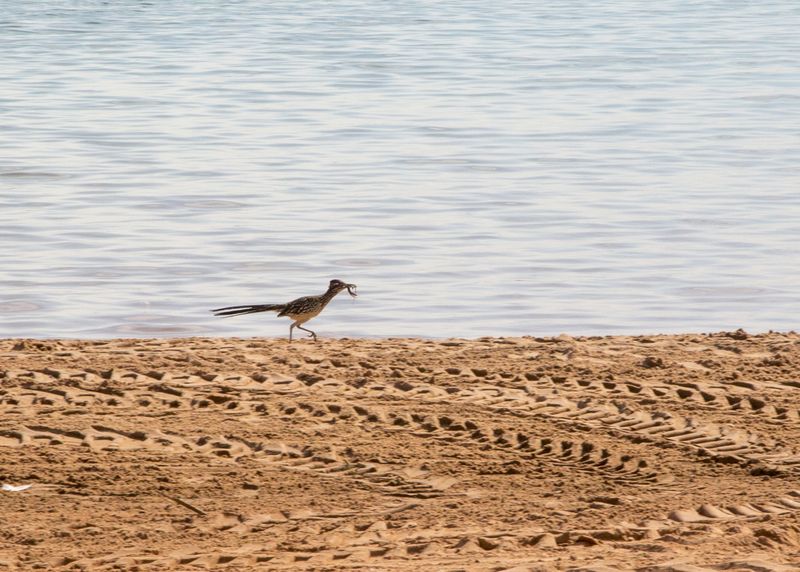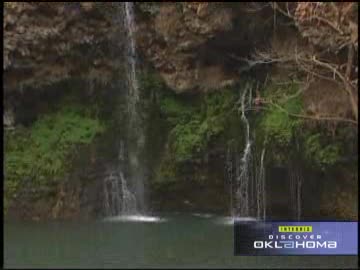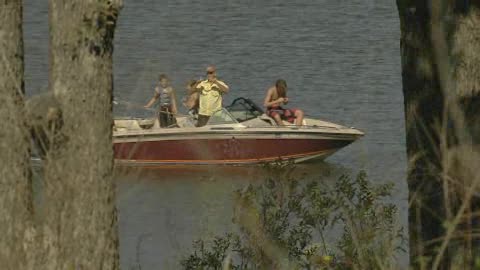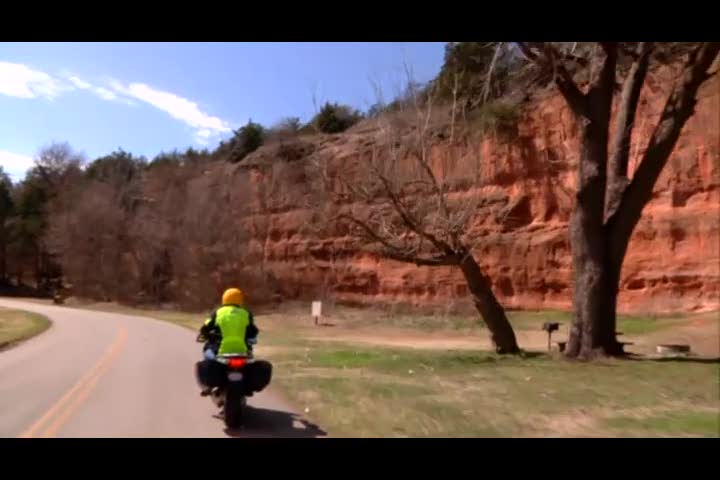Venture out to one of Oklahoma’s state parks, and discover the unexpected wildlife treasures that await you. Each of these parks has surprising sights and fascinating creatures for you to discover.
Keep an eye out for bats during the cavern tour — five different species inhabit the park.
Hike through Cedar Canyon, and you may come across a mountain boomer, the colorful collared lizard that is Oklahoma’s state reptile.
Arrowhead Area at Lake Eufaula State Park
Look to the sky and you might just be lucky enough to see small aircraft landing at the on-site airstrip for those who would like to fly into the park.
Lakeview Lodge guests should make sure and step out on their balcony or porch in the morning and evening to see the deer who come up to the lawn for a snack.
The Beavers Bend area is well-known for trout fishing, but the fish can also be seen in the park’s nature center. A new, 900-gallon aquarium has jets that give it a little current so visitors can see the trout swimming.
For bird watchers hoping to catch a sight of a pinyon jay, golden eagle or black-billed magpie, there’s a birding booth near the office.
Watch for birds like the red-bellied woodpecker and the yellow-bellied sapsucker — the park is a top destination for birders, who love the variety of local and migrant species to be found there.
The park is a terrific place for spotting native wildlife, including bird species like the great blue heron — one of Oklahoma’s largest birds — and possibly a bald eagle during the winter months.
Just northwest of the park is the Fort Cobb Wildlife Management Area, a public hunting area located in the heart of the Central Flyway and known for duck and goose hunting
The park’s environment draws many types of birds, especially woodland and prairie species. Among those to watch for are eagles, scissor-tailed flycatchers, quail and roadrunners.
The park is a great place to spot some western Oklahoma wildlife, including mountain boomers, turkey vultures and black-tailed jackrabbits.
Bernice Area at Grand Lake State Park
Two wildlife observation towers along the trail provide scenic views of the park and lake. The lakeside tower has a great bird’s eye-view of migratory waterfowl, including pelicans and egrets.
It’s possible to see fish up close at Bernice without a rod and reel. The park’s nature center has a 750-gallon tank filled with species native to Grand Lake.
Honey Creek Area at Grand Lake State Park
Each fall, migrating American White Pelicans return to the Grand Lake area. Grove even hosts an annual Pelican Festival in early October to celebrate the birds’ arrival.
The lake’s eastern shores are a favorite winter feeding spot for bald eagles.
A few miles northeast of the park lies the Keystone Ancient Forest, a pristine, 1,360-acre nature preserve filled with wildlife and cedars and post oak trees that are centuries old. Explore the forest along four hiking trails ranging from a paved handicap-accessible trail to more difficult four-mile loops through the Cross Timbers.
Among the Deep Fork Nature Center’s unique exhibits is the Frogatorium, an enclosed habitat for frogs, toads and salamanders.
The Deep Fork Nature Center’s Nocturnal Room has mounted wildlife and sounds of the night for a fully immersive experience.
Keep an eye out for painted buntings: colorful songbirds that arrive in Oklahoma around mid-April. To get a glimpse, try driving slowly along the road from the visitor’s center to Deep Fork Campground.
Rare freshwater jellyfish have been spotted in Lake Murray. The tiny species, which have tentacles but not the stinging power of their larger relatives, like to occupy clear, warm bodies of water.
Lake Texoma may be known for its stripers, but sand bass are also plentiful — and reason to celebrate, at least in nearby Madill. The town hosts a week-long Sand Bass Festival each June that features live music, carnival rides and a Sand Bass Run.
The lake’s shoreline is one of the best in the state for spotting fossils. A good-sized specimen of an ammonite — a fossil of an extinct group of marine animals — is on display in the nature center.
In addition to all the usual lake fun, Lake Thunderbird visitors can also learn to sail with lessons for kids and adults through the Thunderbird Sailing Club. While out on the waters, visitors can see if they can spot crappie, catfish and saugeye swimming under the surface.
Located on 39,000 acres south of the park, the Wister Wildlife Management Area is fertile hunting ground for deer, wild turkey, waterfowl, rabbit and squirrel.
Starting in late November, the park’s Quarry Island is home to Lights on the Island, with more than 300 light displays — including a 32-foot Statue of Liberty and some animated displays. Meanwhile, visitors may be able to catch sight of wintering golden and bald eagles flying overhead.
During the fall, the park gets in the Halloween spirit with its popular Camp or Treat event the Saturday before Halloween. Entry fees are waived, and campers decorate their campsites and hand out candy to children. Visitors may be able to spot animals living within the forest, composed of maple trees, dogwood plants, coral berry bushes, moss and more.
Stop by for the annual Christmas Boat Parade. Held on the first weekend of December, the event features pontoon boats adorned with lights instead of transporting fishermen across the lake in search of sunfish, white bass and channel catfish. The shoreline is also decorated.
The refuge is one of the state’s best spots for bird watching, and the Eagle Roost Nature Trail has an observation deck with a spotting scope where visitors might get a glimpse of over 300 species of migratory birds, including bald eagles in January and February.
Fort Gibson Lake is a prime spot in the winter months for bald eagle watching. The Three Forks Nature Center hosts tours in January.
Check out the Three Forks Nature Center’s snake exhibit to see numerous species of slithery reptiles.
During the winter, the park and nearby Strayhorn Landing are among the best areas in the state for spotting different types of loons. The migratory, fish-eating birds are about the size of a large duck and have a variety of loud, eerie calls.

































